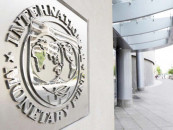‘Risks to public debt remain high’
Ministry warns that more shocks will keep debt above 70% until 2026

The risks to Pakistan’s public debt remain high and any further exchange rate shock would persistently keep the debt above the sustainable level of 70% of the nation’s economy in the next three years, a Finance Ministry report revealed on Wednesday.
The Debt Sustainability Analysis report indicates that Pakistan’s Debt-to-GDP ratio and Gross Financing Needs to GDP ratio are currently exceeding sustainable levels. This assessment highlights the presence of significant risks associated with default.
The report prepared by the Economic Advisor wing of the finance ministry determined that the sustainable Debt-to-GDP ratio for countries like Pakistan is set at 70%. Additionally, if the gross financing needs surpass 15% of GDP, it would become unsustainable. Pakistan is in breach of these two limits and the report suggests that due to any adverse shocks it may remain above the sustainable levels until at least 2026, according to the report.
“The heatmap depicts a high risk since the Debt and the Gross Financing Needs-to-GDP ratios exceed the market access countries DSA thresholds in FY 2023, both in baseline and shock scenarios.”
It is worth noting that since January 2018, the Pakistani rupee’s value has struggled to stabilise, except for a brief period when Dr Reza Baqir led the central bank and made efforts to maintain rupee stability in exchange for significant foreign inflows. Furthermore, the finance ministry emphasised that when considering combined macro fiscal and standardised contingent liability shocks, the debt-to-GDP ratio continues to exceed the 70% threshold. “Gross financing needs remain high, posing several liquidity risks mainly due to high interest rates and pressures on external account,” it added.
The risk assessment conducted revealed that shocks related to real GDP growth, primary balance, real interest rate, exchange rate, and contingent liabilities would lead to an increase in the debt burden, surpassing the 70% threshold and rendering it unsustainable. Notably, in the current fiscal year, the interest rate shock alone has contributed an additional Rs1.5 trillion to the debt servicing cost, exacerbating the burden and consuming 70% of the projected revenues for this fiscal year as per the Federal Board of Revenue (FBR).
The ministry has warned that any shock, be it economic or financial, would result in the gross financing needs remaining above the sustainable threshold of 15% for the next three years. Even without any shock scenario, it is projected that the gross financing needs will range from 19.2% to 18.9% of the GDP during the next three fiscal years, which still exceeds the sustainable level of 15%. However, the ministry highlights that through fiscal consolidation measures and a favourable growth-interest rate differential, it is possible to achieve a declining path for the gross financing needs.
“Despite improvement in the debt dynamics over the medium term, public debt risks remain high,” admitted the ministry.
According to the report, in the previous fiscal year, the public and publicly guaranteed debt increased to 78% of the GDP. This rise was attributed to the depreciation of the rupee and the primary deficit. The report further reveals that the depreciation of the rupee alone contributed to a debt increase equivalent to 6.1% of the GDP.
The external debt to GDP ratio also grew from 34.1% to 36.9% “driving the depreciation of Pakistan’s rupee,” said the finance ministry.
As per the report, the government is legally obligated under the Fiscal Responsibility and Debt Limitation Act to decrease the Debt-to-GDP ratio to 55.2% by fiscal year 2026. However, even in the absence of any shocks, the report estimates that the Public and Publicly guaranteed debt to GDP ratio will still reach 63% in fiscal year 2026, with guarantees accounting for 3.1% of the GDP. Currently, Pakistan’s public and publicly guaranteed debt to GDP ratio stands at 78%, making it impractical to reduce it by nearly one-third within four-years.
The report provides insights into Pakistan’s external and domestic debt, contingent liabilities, and economic outlook for the next three fiscal years. Its publication is a requirement to fulfill a condition of the World Bank loan.
According to the finance ministry, the total public and publicly guaranteed debt surged by 7% to reach Rs55.8 trillion by the end of December 2022. This increase was primarily driven by the growing burden of interest rates and the devaluation of the rupee. Notably, over 37% of the total debt is external, making it particularly susceptible to rupee devaluation.
In the report, the ministry acknowledges that the government is making every possible effort to secure external financing. The report specifically highlights the rollovers of cash deposits from Saudi Arabia and China, as well as the acquisition of $3.7 billion through foreign commercial loans and Sukuk bonds during the first half of the fiscal year.
The analysis of debt sustainability in the report assumes a pick-up in economic growth rate to 3.5% and a reduction of the primary deficit to 0.2% of the GDP in the upcoming fiscal year. However, it is worth noting that the government has struggled to achieve these primary deficit reduction targets in previous years.
Furthermore, the report includes the assumption of “exchange rate stabilisation”. However, given the highly uncertain environment, this assumption may not materialise. Over the past year, the rupee has depreciated by 56%, significantly contributing to the accumulation of debt.
Published in The Express Tribune, April 27th, 2023.
Like Business on Facebook, follow @TribuneBiz on Twitter to stay informed and join in the conversation.



















COMMENTS
Comments are moderated and generally will be posted if they are on-topic and not abusive.
For more information, please see our Comments FAQ